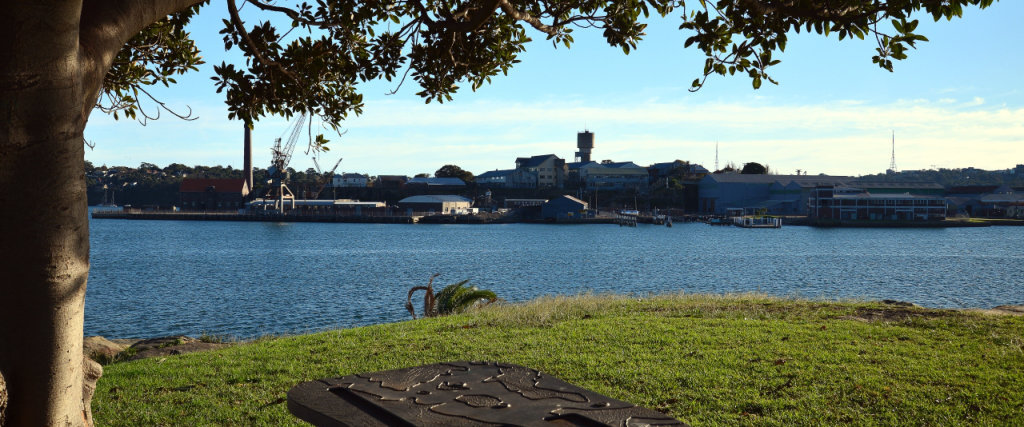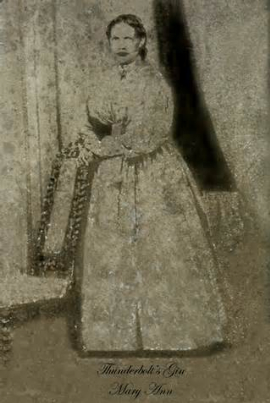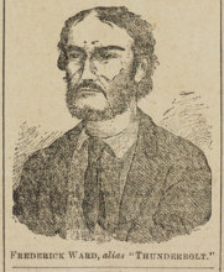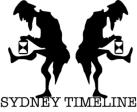

Mary Ann Bugg


This information is from the Biography: Bushranger Frederick Wordsworth Ward
alias Captain Thunderbolt by courtesy of the author Carol Baxter
http://thunderboltbushranger.com.au
Mary Ann Bugg was the eldest child of assigned convict James Bugg and
his Aboriginal "wife" Charlotte and was born at the Australian Agricultural
Company's Berrico outstation on 7 May 1834. A further seven children were
born in the aftermath, with her parents marrying in 1848.
Late in 1837, James Bugg expressed concern that his two children should
receive an education "so as to ensure the abandonment of their savage life".
The Company's Commissioner, Colonel Henry Dumaresq, approached the
authorities and eventually received the Governor's approval to send them
to the Orphan School "until the Native Institution at Port Phillip [Melbourne]
is in a state to receive them". Plans were put on hold when Dumaresq died
suddenly. A year later, on 24 February 1839, Mary Ann and her brother John
were baptised in a Church of England ceremony on the Company's estate.
The following day Dumaresq's temporary replacement wrote to the Governor
advising that the children had been baptised and that James Bugg was
proceeding with them to Sydney "for the purpose of disposing of them as
you may be pleased to direct".
As it turned out, Mary Ann and her brother were not admitted to the Orphan
Schools, perhaps because Governor George Gipps had replaced Governor
Richard Bourke in the interim and policy had changed. A magistrate who
knew the Bugg family later reported that Mary Ann had been "sent to a
school in Sydney where she remained about five years", so she perhaps
attended a day school and boarded nearby, or boarded with the family of
a cleric who tutored on the side.
Mary Ann returned to her family at Berrico in the mid-1840s where she was
"brought up in settled habits like other children on a station". On 1 June 1848
she married ex-convict Edmund Baker at the Anglican church at Stroud.
They seem to have had a daughter Helena born around 1849, although
this cannot be stated with certainty. For some unknown reason, they
separated in 1849 or 1850, possibly because Baker died although no trace
has been found of his death.
In July 1851, Mary Ann and her new partner, shepherd John Burrows, had
a son James born at the Turon River. Her obituary reported that she "was
at the Turon diggings and saw the first gold got there", although Burrows
apparently continued to work as a shepherd in the Turon district rather than
digging for gold. By February 1854 when their second son, John, was
baptised, Burrows was shepherding at Louee station near Mudgee. The
couple separated in 1854 or 1855, again for unknown reasons.
By mid-1855, Mary Ann was living with ex-convict James McNally. A daughter
Mary Jane was born early in 1856, a son Patrick William late in 1857, and
another daughter Ellen in March 1860. McNally was recorded as a farmer
at Cooyal later that year and continued to live in the Mudgee district until his
death in 1875.
Early in 1861, Mary Ann fell pregnant to ticket-of-leave convict
Frederick Wordsworth Ward who had been granted permission to reside
in the Mudgee district until his period of servitude expired in 1866. In mid-
1861, Fred took Mary Ann back to her father's farm at Monkerai where
their daughter Marina Emily was born in October 1861. However Fred was
not around to greet the new arrival. Ticket-of-leave regulations decreed that
he remain in his muster district and attend a three-monthly muster, so he
broke one rule when he left the district, and broke another when he failed
to return in time for the muster. Accordingly, his ticket-of-leave was revoked.
He compounded the problem by riding in on a stolen horse and was
sentenced to another three years servitude. He returned to the Cockatoo
Island penal settlement soon afterwards.
Claims have been made that Mary Ann helped Fred Ward escape from
Cockatoo Island two years later in September 1863, but the evidence proves
otherwise. "When Ward came to grief," wrote the above-mentioned magistrate
in 1866, Mary Ann "returned to her father's home and remained there till
she obtained employment as a domestic in a family near Dungog, and she
remained so employed in the same locality till Ward joined her after his
escape from Cockatoo Island."
Fred and Mary Ann fled to the Culgoa River, north-west of Walgett, where
they camped until early 1865 when Fred joined forces with another three
villains and began robbing in the district. Mary Ann was apprehended by
the police in March 1865 after they found stolen goods in her camp but she
feigned labour and the police were forced to leave her at Wilby Wilby station.
Fred and his gang rescued her early in April and took her down to the
Tamworth district where Fred engaged another part-Aboriginal woman to
assist with her delivery. He and his gang then returned to bushranging.
Their daughter Eliza was born in mid-1865.
In March 1866, the police encountered the Wards again at their Pigna
Barney Creek camp in the Barrington Tops. Mary Ann was taken into custody
for vagrancy. After her conviction, a Parliamentary outcry led the Attorney
General to recommend her release on the grounds that the charge was not
properly prepared.
Early in 1867, Mary Ann was apprehended by the police for being in
possession of stolen goods. Although she claimed to have purchased
them, she was unable to produce receipts so she was again sent to gaol.
A concerned magistrate looked into her case and found that a shopman
could attest to her purchases. Again she was released from gaol.
Mary Ann fell pregnant again late in 1867 and their son Frederick Wordsworth
Ward junior was born in August 1868. By that time, Fred and Mary Ann had
separated, and she was working at Griffin's Inn at Carroll.
In 1869 Mary Ann encountered John Burrows again and they settled together
in the Mudgee district, spending the rest of their lives together. The last of
Mary Ann's fifteen known children were born in the 1870s. In her final years -
presumably after Burrows death - she worked as a nurse to support herself.
She died at Mudgee on 22 April 1905 at her home in Gladstone Street,
Mudgee, her cause of death listed as "senile decay".
For the full story of Mary Ann's life and activities as Thunderbolt's
bushranging companion, see Captain Thunderbolt and his Lady:
the true story of bushrangers Frederick Ward and Mary Ann Bugg


Early in 1861, Mary Ann fell
pregnant to ticket-of-leave convict
Frederick Wordsworth Ward aka
Captain Thunderbolt who had
been granted permission to reside
in the Mudgee district until his
period of servitude expired in 1866 .
. .















